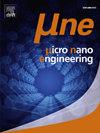Nanofabrication of sharp conductive diamond tip probe chips and their application in reverse tip sample scanning probe microscopy
IF 3.1
Q2 ENGINEERING, ELECTRICAL & ELECTRONIC
引用次数: 0
Abstract
Recently, a new scanning probe microscopy (SPM) concept called reverse tip sample scanning probe microscopy (RTS SPM) was introduced. Here, a sample is mounted at the end of a cantilever beam and scans over a tip that is integrated into an array of hundreds of SPM tips, overcoming one of the major limitations of the SPM technique, namely, the time-consuming and experiment-interrupting manual tip exchange step. However, to fully exploit this novel approach, a chip with an array of densely packed, nanometer-sharp, and durable SPM tips is essential. Therefore, we have developed a fabrication process to integrate such an array of sharp, high aspect ratio, doped diamond tips – referred to as hedgehog full diamond tip (HFDT) – into so-called probe chips, facilitating high-resolution SPM measurements and enabling rapid and seamless sample movement from one tip to another within the RTS SPM framework. An array of pyramidally shaped, doped diamond tips is fabricated through consecutive molding and diamond deposition steps. A supporting membrane is formed by metal deposition and electroplating, followed by selective underetching of the silicon substrate to release the tip array membrane and enable probe chip assembly. Finally, a self-patterned dry etching step is employed to generate multiple nanoscopic sharp tips on top of the base diamond pyramids. In this work, we present our developed and optimized probe chip technology and demonstrate its high electrical conductivity, robustness under high tip load force, and excellent spatial resolution, rendering it highly suitable for diverse electrical SPM measurement modes.

锋利导电金刚石尖端探针芯片的纳米制造及其在反向尖端样品扫描探针显微中的应用
近年来,人们提出了一种新的扫描探针显微镜(SPM)概念,即反向尖端样品扫描探针显微镜(RTS SPM)。在这里,样品被安装在悬臂梁的末端,并扫描一个尖端,该尖端集成到数百个SPM尖端阵列中,克服了SPM技术的主要限制之一,即耗时和实验中断的手动尖端交换步骤。然而,为了充分利用这种新方法,一个具有密集排列、纳米级锐度和耐用SPM尖端阵列的芯片是必不可少的。因此,我们开发了一种制造工艺,将这种尖锐的,高纵横比的掺杂金刚石尖端阵列(称为刺猬全金刚石尖端(HFDT))集成到所谓的探针芯片中,促进高分辨率SPM测量,并在RTS SPM框架内实现从一个尖端到另一个尖端的快速无缝样品移动。通过连续成型和金刚石沉积步骤,制备了一组金字塔形的掺杂金刚石尖端。通过金属沉积和电镀形成支撑膜,随后对硅衬底进行选择性下蚀刻以释放尖端阵列膜并使探针芯片能够组装。最后,采用自图画化的干刻蚀步骤,在金刚石金字塔基面上生成多个纳米级尖头。在这项工作中,我们展示了我们开发和优化的探针芯片技术,并展示了其高导电性,高尖端负载力下的稳健性和出色的空间分辨率,使其非常适合各种电SPM测量模式。
本文章由计算机程序翻译,如有差异,请以英文原文为准。
求助全文
约1分钟内获得全文
求助全文
来源期刊

Micro and Nano Engineering
Engineering-Electrical and Electronic Engineering
CiteScore
3.30
自引率
0.00%
发文量
67
审稿时长
80 days
 求助内容:
求助内容: 应助结果提醒方式:
应助结果提醒方式:


